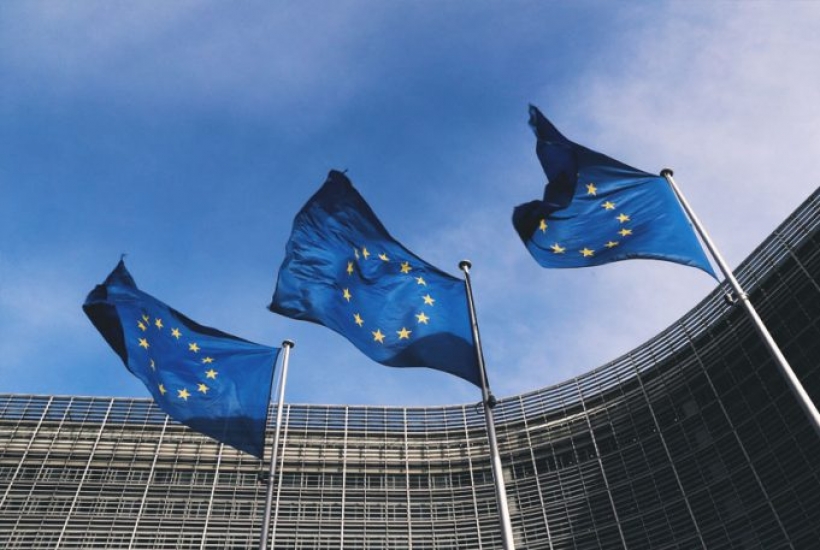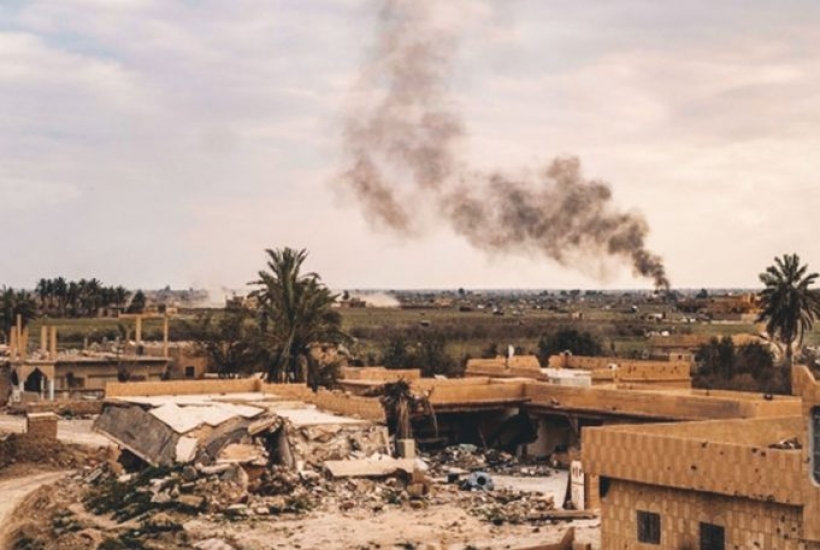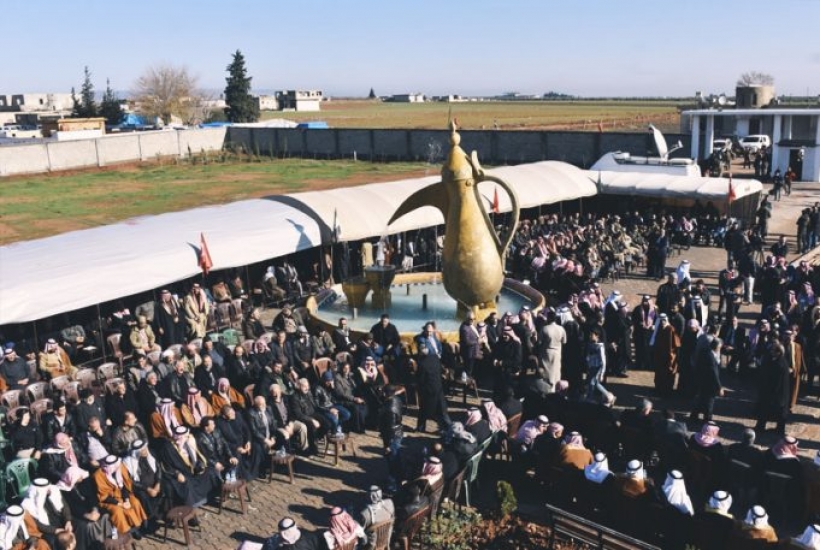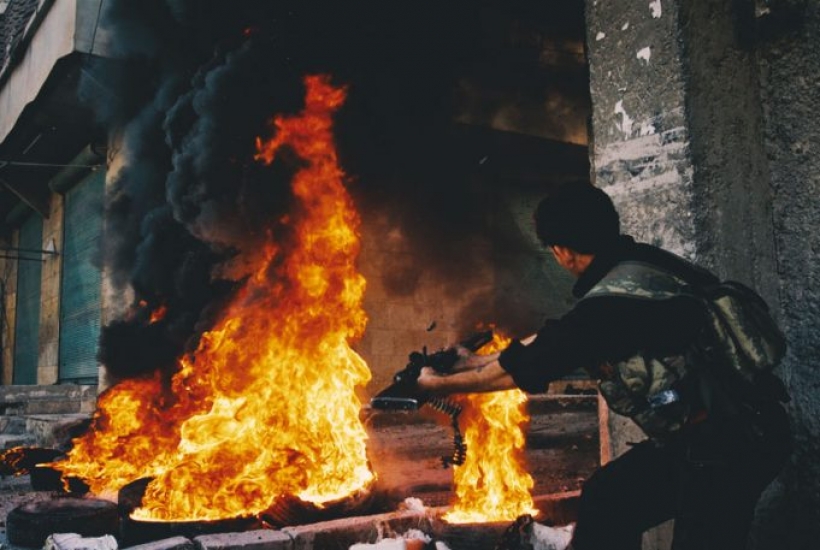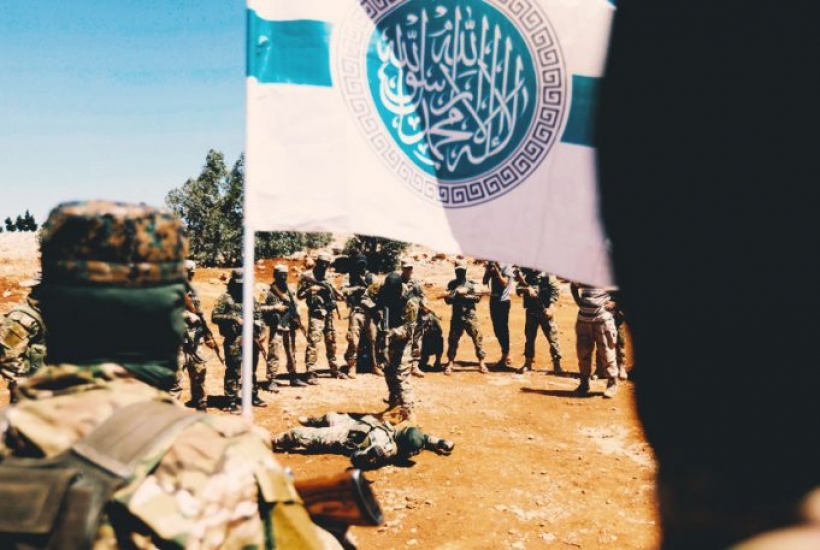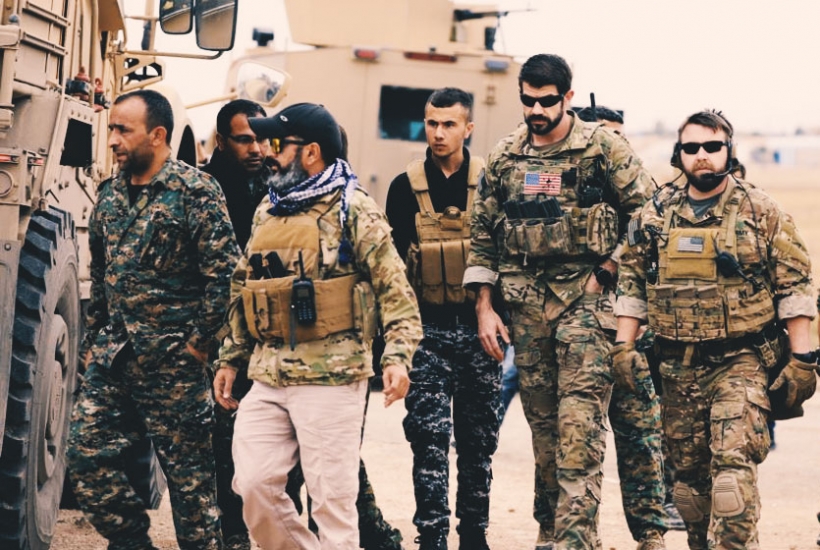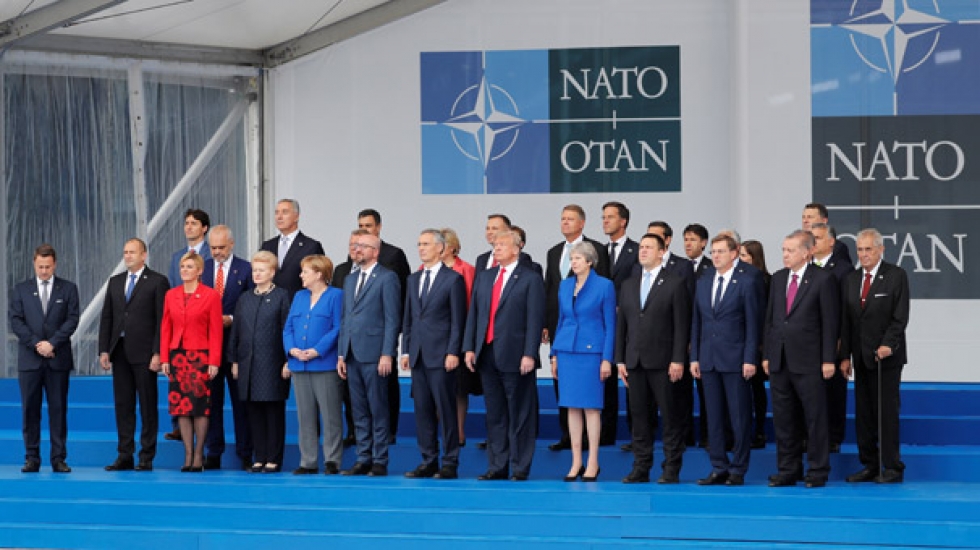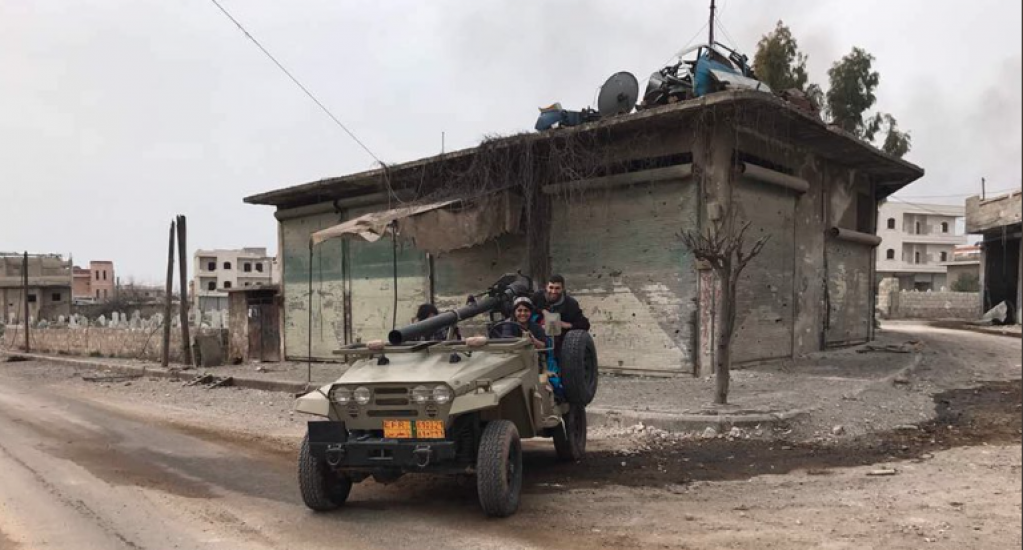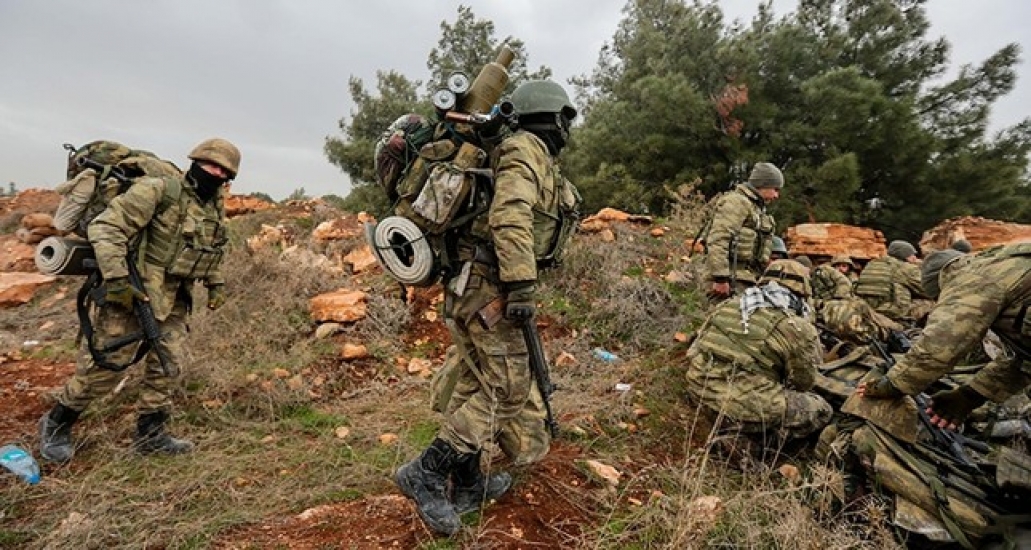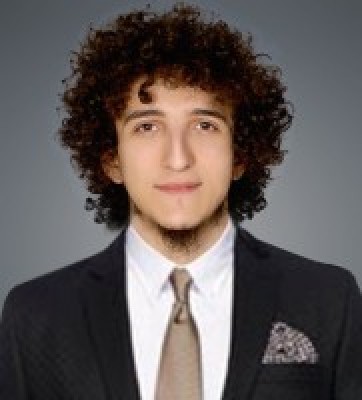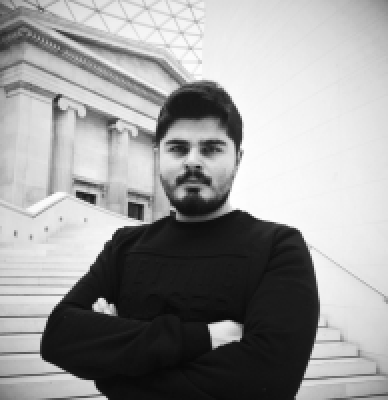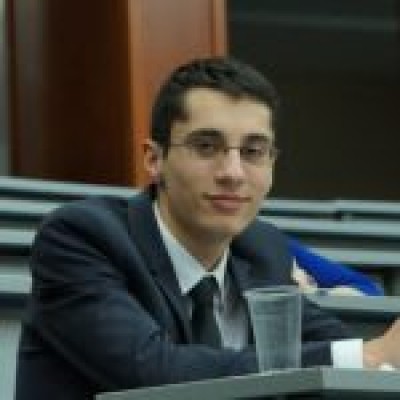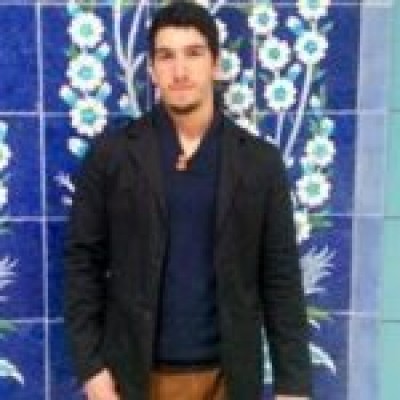Opinion
How much the EU has been successful in the war on terror in Syria under its counter-terrorism strategy?
How much the EU has been successful in the war on terror in Syria under its counter-terrorism strategy?
Witnessing the evolution of terrorism, remarkably with the fact that terrorism has indicated the signs of transnational entities in the 9/11 attacks via a powerful network enhanced by advanced technological developments. The threat perception to national security has been redefined and codified by the US through the Bush Doctrine as it fostered the prominent role to propel the other countries worldwide in determining a threat perception and finding itself a huge place in the legislations. The European countries, with no doubt, followed the path of the US which has declared “war on terror”. In 2015, Europe experienced its peak when there were 17 terrorist attacks. Before then, for instance in 2014 only two attacks were carried out.[1] Later on, the Council of Europe (CoE) adopted the EU counter-terrorism strategy, as it is mentioned in the strategy, it was adopted “…to fight terrorism globally and make Europe safer”. [2] The non-stop evolution of the terrorism now and then, specifically with the second big wave after Al-Qaida and DAESH, the war on terror agendas of European countries started to consider Syria.
Putting the fighting with terrorism on top of its priorities, the EU’s counter-terrorism strategy can be defined through its strategic commitment to combat terrorism within the global context while respecting human rights, freedom, security, and justice for its citizens.[3] It is constructed around four principles, respectively, prevent people from turning to terrorism by inhibiting the recruitment in Europe as well as international extent; protect the EU citizens and infrastructure through decreasing the weaknesses in the face of attacks; pursue terrorists while investigating, cutting off their access to materials and funding, inhibiting their communications as well as travel; and finally respond through well-coordinated organization to minimize and manage the consequences of terrorist attacks to combat terrorism effectively. Furthermore, international cooperation with the third countries and international institutions has been highlighted and emphasized repeatedly by the CoE in the revised strategy adopted in 2014. In particular, regarding the EU’s activities under the framework of its counter-terrorism strategy, Syria ought to have a pivotal role as it has been the main battleground for DAESH. In this vein, once the activities of DAESH showed the signs of urgency, the EU, as mentioned above, followed the pathway of US and took part in the US-led international coalition (established in 2014 to defeat DAESH). In this way, the EU started to approach YPG/PKK as an organization that helps fight against DAESH. [4]
In every occasion, the EU reiterated the need for action towards the recruitment of foreign fighters as it became a greater concern throughout Europe. To tackle with financing and recruitment of foreign fighters, special attention has been giving rising in the strategy under the prevent strand which focuses the roles of both external actions and internal actions. Additionally, European Counter Terrorism Center was established at Europol for information exchange and operations in 2015. In the same year, EU Internet Forum was established by the Commission to bring the member states, Europol and remarkable social media companies together. It is to make sure that illegal content, especially the terrorist propaganda is taken down as quickly as possible. The High-Level Commission Expert Group on radicalization was set up by the Commission to further strengthen the activities to counter radicalization which paves a way for terrorism. Most remarkably in 2017, the CoE adopted a strategy for Syria in which the political solution was emphasized rather than a military one to defeat DAESH. It encouraged the political transition by promoting democracy[6] and concentrated more on the humanitarian aids in Syria. Moreover, the EU also adopted UN Security Council Resolution 2253/2015 as an EU binding law to impede financial resources available to DAESH.
To see whether the EU is successful with its war-on-terror, its 4 main pillars under its counter-terrorism strategy should be evaluated. The first principle, prevent, has contributed to considerable changes in the EU legislation on its counter-terrorism policies to impede recruitment and financing. Nevertheless, the EU remains slow to impede radicalization within Europe since there are hundreds of Europeans radicalized and recruited by using the internet and social media with a link to disseminated terrorist content.[7] Moreover, most returnees are not prosecuted even though they pose a threat due to augmented lone-actor terrorist attacks. It clearly shows that each of them can carry out an attack relying on their former experiences and linkages in the battleground. Due to the domestic law restrictions within the EU countries, there were not a concrete political solution except several sentences given by the United Kingdom and Denmark.
However, a question comes to one’s mind: why the EU does not take a concrete step in the field? There may be two reasons: The EU tends to leave the ground for the US’ activities and follow its actions as it leads the coalition and has the biggest role in determining the further steps on military operations. Not to forget, the EU announced the US as its top partner in its counter-terrorism strategy. On the other hand, the EU has been surrounded by its legal barriers in terms of military operations and solid responses. Whereas the comprehensive responses entail being complemented in military operations, the balance between the two still does not seem to be sustained.
[1] “Terrorism in the EU: terror attacks, deaths and arrests”, European Parliament, 25 July, 2018, accessed via: www.europarl.europa.eu/news/en/headlines/security/20180703STO07125/terrorism-in-the-eu-terror-attacks-deaths-and-arrests [Accessed date 15.12.2019]
[2] “The European Union Counter Terrorism-Strategy”, Council of The European Union: Brussels, 2005.
[3] “The European Union Counter Terrorism-Strategy”, Council of The European Union.
[4] Carmen-Cristina Cîrlig, “The international coalition to counter ISIL/Da’esh (the ‘Islamic State’)”, European Parliamentary Research Service (EPRS), 2015.
[5] “Outline of the counter-terrorism strategy for Syria and Iraq, with particular focus on foreign fighters”, Council of the European Union: Brussels, 2015.
[6] “Council adopts EU strategy on Syria” European Council Council of the European Union, 3 April 2017, accessed via: https://www.consilium.europa.eu/en/press/press-releases/2017/04/03/fac-conclusions-syria/ [Accessed date 10.12.2019]
[7] Gabe Stutman, “Making Memes in a Warzone”, 3 August 2017, accessed via: https://theoutline.com/post/2052/making-memes-in-a-warzone?zd=1&zi=2skpf5ze [Accessed date 11.12.2019]
Daesh in New Avatar
Once Daesh was once had population of 10 million people within its borders. It stretched across two countries Iraq and Syria contained major towns and cities, oil fields and factories. But now Daesh has lost more than 99 percent of the territory it once held in Syria and Iraq its territory has now shrunk to a tiny pocket in Syria’s eastern Deir Ezzor province, with its fighters holed up in the village of Baghouz near the Iraqi border[1]. There is a perception growing among the people that these are the end days of Daesh but many analysts and US intelligence community warns that the group will still be a long-term threat. While the physically held territory is about to extinguish the extremist group still has thousands of fighters in its ranks in Iraq, Syria and beyond[2]. Daesh has largely melted away from towns and villages in the conflict zone rather than confront advancing Iraqi and Syrian forces[3]. Even no significant top leader of Daesh has been captured or killed in recent offensives it means that Daesh top leaders and strategists have left the contested areas and are preparing for next phase of war.
Daesh’s roots can be found in the Iraqi insurgency against the US led invasion of Iraq in 2003 when the founding leaders of Daesh were waging an insurgency campaign against coalition forces in Iraq. Even with the fewer resources at disposal now Daesh will be a deadly insurgent group as it takes much less resources to carry out terrorist/insurgent attacks rather than defending a territory. Daesh was planning for a long-term insurgent campaign from at least couple of years now especially after losing Mosul. After the fall of Mosul, the group adopted a calculated strategy of withdrawing to conserve manpower and pivot away from holding territory to pursuing an all-out insurgency in coming future[4]. The reality is that since losing Mosul, its most sizeable and symbolic territorial possession, the Daesh has not fought to the last man and last bullet to maintain control of any other population centre. Even more surprising was its retreat in areas long believed to be its strategic base the borderlands of Iraq, Syria and especially in the Euphrates river valley, where it had experience fighting or operating in for around a decade now and where it remerged powerfully in 2014[5]. The group has shifted its base to desert and rural areas as rural- and desert-based insurgency is no less important than urban warfare to deplete its enemies, recruit members, and lay the groundwork for a comeback[6].
The extremists have already stepped up hit-and-run attacks in towns they have lost. This tactic diverged from the group’s tendency at the height of its expansion in 2014 to engage in conventional attacks, including attacks via convoys and heavy artillery barrage. The new tactics tended to involve small units attacking from behind enemy lines or through hasty raids. Reverting back to the old insurgency and terror tactics enabled the Daesh to penetrate otherwise well-secured areas[7]. Previous attempts to attack through conventional fighting units had failed, even while the group was at the height of its power. These hit-and-run attacks also serve another very useful purpose that they are able to demonstrate that nothing is out of reach for them, even after their ability to control territory plummets. In this regard it should be noted that Daesh is an adaptive and determined enemy. Its new avatar from an organization with a fixed headquarters to a clandestine terrorist network dispersed throughout the region and the globe will be deadlier. The result of this transition will be that Daesh perpetrated violence should be far less concentrated and more dispersed which will be hard to detect and control[8].Part of the revised Daesh strategy will likely include a rejuvenated focus on planning and conducting spectacular attacks in the West in order to remain militarily relevant and to inspire its followers globally[9]. To adequately plan for the next phase of the war it is critical that the coalition forces fighting against Daesh understands the variety of potential tactics undertaken by the group. This is the need of the hour that a new strategy to counter Daesh should be formulated rather than hasty announcement of group defeat. For fighting highly adaptive adversaries like Daesh a new approach should have different mix of tools including military, intelligence, diplomatic, social and economic means. Moreover, Daesh toxic ideology can still affect an entire generation so next campaign against Daesh should also focus on ideologically eradicating it. An ideological defeat is a much tougher task because anti-extremism campaigns requires patience and resilience but these measures offer long term solution as they tackle the root causes of the radical ideologies[10]. United States and allies have to understand that ideological defeat of Daesh is as important as its military defeat and only one phase of war is over and next one is about to come.
Daesh’s roots can be found in the Iraqi insurgency against the US led invasion of Iraq in 2003 when the founding leaders of Daesh were waging an insurgency campaign against coalition forces in Iraq. Even with the fewer resources at disposal now Daesh will be a deadly insurgent group as it takes much less resources to carry out terrorist/insurgent attacks rather than defending a territory. Daesh was planning for a long-term insurgent campaign from at least couple of years now especially after losing Mosul. After the fall of Mosul, the group adopted a calculated strategy of withdrawing to conserve manpower and pivot away from holding territory to pursuing an all-out insurgency in coming future. The reality is that since losing Mosul, its most sizeable and symbolic territorial possession, the Daesh has not fought to the last man and last bullet to maintain control of any other population centre. Even more surprising was its retreat in areas long believed to be its strategic base the borderlands of Iraq, Syria and especially in the Euphrates river valley, where it had experience fighting or operating in for around a decade now and where it remerged powerfully in 2014. The group has shifted its base to desert and rural areas as rural- and desert-based insurgency is no less important than urban warfare to deplete its enemies, recruit members, and lay the groundwork for a comeback.
The extremists have already stepped up hit-and-run attacks in towns they have lost. This tactic diverged from the group’s tendency at the height of its expansion in 2014 to engage in conventional attacks, including attacks via convoys and heavy artillery barrage. The new tactics tended to involve small units attacking from behind enemy lines or through hasty raids. Reverting back to the old insurgency and terror tactics enabled the Daesh to penetrate otherwise well-secured areas. Previous attempts to attack through conventional fighting units had failed, even while the group was at the height of its power. These hit-and-run attacks also serve another very useful purpose that they are able to demonstrate that nothing is out of reach for them, even after their ability to control territory plummets. In this regard it should be noted that Daesh is an adaptive and determined enemy. Its new avatar from an organization with a fixed headquarters to a clandestine terrorist network dispersed throughout the region and the globe will be deadlier. The result of this transition will be that Daesh perpetrated violence should be far less concentrated and more dispersed which will be hard to detect and control.
Part of the revised Daesh strategy will likely include a rejuvenated focus on planning and conducting spectacular attacks in the West in order to remain militarily relevant and to inspire its followers globally. To adequately plan for the next phase of the war it is critical that the coalition forces fighting against Daesh understands the variety of potential tactics undertaken by the group. This is the need of the hour that a new strategy to counter Daesh should be formulated rather than hasty announcement of group defeat. For fighting highly adaptive adversaries like Daesh a new approach should have different mix of tools including military, intelligence, diplomatic, social and economic means. Moreover, Daesh toxic ideology can still affect an entire generation so next campaign against Daesh should also focus on ideologically eradicating it. An ideological defeat is a much tougher task because anti-extremism campaigns requires patience and resilience but these measures offer long term solution as they tackle the root causes of the radical ideologies. United States and allies have to understand that ideological defeat of Daesh is as important as its military defeat and only one phase of war is over and next one is about to come.
Sources
1‘We will finish them soon’https://www.independent.co.uk/news/world/middle-east/isis-syria-defeat-islamic-state-end-caliphate-sdf-kurds-a8757991.html2 What next for IS?https://www.bbc.com/news/world-middle-east-455475953 Insurgents Again: The Islamic State’s Calculated Reversion to Attrition in the Syria-Iraq Border Region and Beyondhttps://ctc.usma.edu/insurgents-again-the-islamic-states-calculated-reversion-to-attrition-in-the-syria-iraq-border-region-and-beyond/4 How ISIS Survives the Fall of Mosulhttps://www.theatlantic.com/international/archive/2017/07/mosul-isis-propaganda/532533/5 ISIS Could Rise Againhttps://www.foreignaffairs.com/articles/syria/2017-12-15/isis-could-rise-again6 Officials Eye Euphrates River Valley as Last Stand for ISIS https://www.nytimes.com/2017/08/31/us/politics/isis-military-us-iraq-syria-euphrates.html67 Insurgents Again: The Islamic State’s Calculated Reversion to Attrition in the Syria-Iraq Border Region and Beyondhttps://ctc.usma.edu/insurgents-again-the-islamic-states-calculated-reversion-to-attrition-in-the-syria-iraq-border-region-and-beyond/8 Insurgents Again: The Islamic State’s Calculated Reversion to Attrition in the Syria-Iraq Border Region and Beyondhttps://ctc.usma.edu/insurgents-again-the-islamic-states-calculated-reversion-to-attrition-in-the-syria-iraq-border-region-and-beyond/9 How ISIS Is Transforminghttps://www.foreignaffairs.com/articles/middle-east/2017-09-25/how-isis-transforming10 Defeating ISIS and Al-Qaeda on the Ideological Battlefieldhttps://digital-commons.usnwc.edu/cgi/viewcontent.cgi?referer=https://www.google.com.au/&httpsredir=1&article=1015&context=ciwag-case-studies
The Unspoken Syrian Tribes in the Syrian Civil War Ömer Özkizilcik
In the pre-war era of Syria, Arab tribes would send their youth to Gulf countries in order to provide families with additional income. With the war, many tribespeople had to flee and are now working in Turkey. For the tribes of Syria, the civil war has partially moved Turkey to the previous role of Gulf countries. Tribesmen in Turkey are sending parts of their income to their relatives in Syria and are organizing themselves in political and social structures. The tribes of Syria, and especially those in YPG-held areas, could play a significant role in enabling Turkey to push against the terror threat posed by the YPG on the bases of mutual interest.
For example, the tribes of Manbij have been divided geographically. While some live in Turkey and the Euphrates Shield areas, others still live in Manbij. In order to unite again in their hometowns, the tribes of Manbij released a statement that they reject the Manbij roadmap between Turkey and the U.S. and that they demand a direct Turkey-supported military operation by the National Army to liberate their hometowns from the YPG. Bushaban – the biggest tribe in Manbij – was historically moved by the Assad regime to Manbij as part of the Arabization policy. Therefore, the Bushaban tribe has a historical dispute with Syrian Kurds and is alienated by the current Kurdish governance within their hometowns. In the eyes of the tribes of Manbij, Turkey is the only foreign actor involved in Syria, who might enable them to get rid of the Marxist-Kurdish YPG.
The tribes of Raqqa and DeirEzzor, which are located in the south of the discussed safe-zone, have their share in pushing Turkey to the east of the Euphrates. The six biggest tribes in the regions are Walda, Afadla, Sabkha, Ougaidat, Baggara, and Busaraya. Being grounded in historical enmities, territorial disputes, ethnic and ideological tensions, the tribes of the region have a hostile relation to the YPG. The Walda tribe for example was partially moved by the Assad regime in the 60s to Qamishli and Hasakah and are seen by the Syrian Kurds as ‘strangers who took their historic lands’ and were excluded by the YPG from any participation or voting in Qamishli and Hasakah. The Baggara tribe has a violent past with Syrian Kurds as they helped the Assad regime crackdown the Kurdish rebellion in 2004 and fought against the alliance between Syrian Kurds and the Bedouin Shammar tribe in 1944.
The Bedouin Shammar tribe is an exception among the tribes in eastern Syria, hostile to the Arab tribes and allied with the Syrian Kurds. Currently, the Shammar tribe is militarily organized under the Sanadid Forces as a close ally of the YPG. The Ougaidat tribe also played an important role in the said crackdown and the war. While the Afadla and the Busaraya tribe have expressed their rejection of the YPG in Arab cities, the Sabkha tribe demanded that cities should be governed by its own people.
While all these tribes have fellow tribespeople living in Turkey as refugees, they also welcome a bigger Turkish role in their hometowns and prefer Turkey and Turkey-trained armed Syrian opposition to the U.S.-backed YPG forces. The Walda, Afadla, and Sabkha tribes have welcomed the possible role of Turkey in the liberation of Raqqa, but were frustrated to see the U.S. preferring to work with the YPG. In the eyes of the Busaraya tribe, Turkey is a natural ally to contain the role of the YPG and Iran in Syria. The Baggara tribe also prefers Turkey and Turkey-backed Syrian rebels over the YPG and Iran, and has been specially organized and trained under the 20th Brigade by Turkey in northern Aleppo. Turkey has welcomed many leaders of the Ougaidat tribe in Turkey and is organized in northern Aleppo under the Jaysh al Sharqiyyah formation.
Many tribesmen of the listed six above are also fighting under the umbrella of the National Army. In the past, all of these listed six tribes were formerly important supporters of the Free Syrian Army and provided many factions with supply and fighters. For these tribes, Turkey has to back a military operation east of the Euphrates to get rid of the invaders, and to re-gain control back over their hometowns. Therefore, in addition to many smaller tribes, these tribes are trying to push Turkey to take action. Another reason why these tribes prefer Turkey is their animosity against Iran and Iranian-backed Shia militias. The rejection of the Iranian role in Syria is hugely spread among the tribespeople. As tribes in Northern Syria share Turkey’s interest of kicking YPG out and US’ interest to contain Iran, they are looking forward for a Turkish operation in the east of the Euphrates.
The non-YPG elements in the Syrian Democratic Forces (SDF) obtained different attitudes in their relation within this umbrella. While some like the Sanadid Forces allied with the YPG based on mutual interests, others joined them because they perceived the YPG as the lesser evil in comparison to Daesh. For example, many of the fighters in south DeirEzzor are from the Shaitat tribe, while many others joined the Turkish-trained Ahrar al-Sharqiyyah in northern Aleppo. In case Turkey gets into these areas, many of the non-YPG elements within the SDF might defect and join the Turkish-trained umbrella as many of their relatives already joined the National Army.
In general, the tribes in YPG-held areas are sympathetic towards Turkey with the exception of the Shammar tribe. While Turkey and the U.S. discuss a potential safe-zone in northern Syria, especially in the areas below the 20-mile line, there are tribes who are close to Turkey and see opportunities in cooperating with Ankara in order to get rid of the YPG, prevent an Iranian expansion, and to ensure their own governance. While discussions about the declared partial withdrawal of the U.S. continues, depending on the goodwill of the U.S. and Turkey, the tribes in the region could function as a vehicle to ensure an agreement while preserving Turkish and American interests.
Source: https://thenewturkey.org/the-unspoken-syrian-tribes-in-the-syrian-civil-war
Syria’s Unending Inter-Rebel Conflict: The War Within The Opposition Saleh Seyidli
Syria’s Unending Inter-Rebel Conflict: The War Within The Opposition
Since the early months of the Syrian War, the main problems of the Syrian opposition were failure to create one unified political body to represent all sides opposing the Assad regime, and the inability of different armed groups fighting on the ground to create a unified military alliance. Seven years later, matters for the opposition got worse and the lack of unity within opposition caused it some serious strategic losses during the war as well as international credibility. So, what is the Syrian inter-rebel conflict, how was Assad regime able to radicalize different Syrian opposition armed groups and how did it all affect the course of war?
July 2011 was marked with the foundation of the FSA, which presented itself as an “armed group, with the aim to bring down the Assad regime and to establish a democratic state”[1]. FSA was the main opposition group in the first year of the civil war[2]However, at the same time; other groups started emerging on the surface. The influential groups such as Jaysh al-Islam, Ahrar al-Sham and al-Qaeda affiliated al-Nusra Front also emerged around July-August 2011. One of main difference between FSA, Islamist groups and al-Qaeda were their vision of a post-Assad Syria. While FSA claimed to be fighting for a “secular and democratic Syria, where rights of all Syrians would be respected”[3], the Islamist groups’ objectives varied from creating the “Islamic democracy”[4]to an “Islamic emirate under Sharia law”[5]. In the beginning of the war, all groups cooperated with each other under the same goal of overthrowing the Assad regime. However, the leaderships of all groups understood perfectly well that such cooperation is only temporary, but 2 major factors allowed disagreements between various groups to escalate in to a full-fledged conflict.
Firstly, the controversial decision of the Assad regime to release political prisoners. In May 2011, the Assad regime ordered a mass release of political prisoners, but majority of people, who got amnesty, were islamists or radicals, many of whom had military experience and connections with Islamist groups. People like Zahran Alloush (ex-leader of Jaysh al-Islam), Hassan Abboud (ex-leader of Ahrar al-Sham), Ahmad Issa al-Sheikh (leader of Suqour al-Sham), Awaad al-Maklaf and Abu Atheer al-Absi (senior personnel of ISIS) were all released from Syrian prisons, while many Syrian oppositions activists, who didn’t have any ties with islamists or extremist groups remained in jail.[6]So, the decision of the Assad regime to release these wasn’t a mistake, it was a well calculated political move. The regime knew that those will join an uprising against him and he was right. From the end of 2012, Islamist groups started to take over Syrian uprising and overshadow the FSA, which leads to gradual radicalization of Syrian opposition armed groups .
Secondly, the issue of leadership and hierarchy within Syrian opposition armed groups also became a flashpoint. One of the main reason of the FSA’s decline and the start of dominance of islamist groups was an issue of leadership within FSA. Till the late 2012, FSA tried to operate as a central command, but as the conflict progressed, it became more like a network of various armed organizations in different parts of Syria[7], each of whom had their own leader, hierarchy, name, but accepted the identity of FSA. The gradual decline of centralization within FSA’s structure weakened the organization’s positions in Syria and later made it vulnerable to ISIS expansion in summer of 2013 and assault by some other islamist groups. The Russian military campaign which was launched in October of 2015 and YPG’s expansion in north of Aleppo in the beginning of 2016 further weakened FSA and allowed islamist groups’ influence to grow within Syrian opposition.
The problem of leadership and cooperation was also an issue within Syrian islamist groups as well. From 2013 to 2015, the biggest rebel alliance was the “Islamic Front”, which composed of main islamist groups like Ahrar al-Sham, Jaysh al-Islam, Suqour al-Sham, Kurdish Islamic Front, Liwa al-Haqq and others. The influential Tawhid Brigade was also part of the alliance.[8]Islamic Front fought against government forces, different pro-government militias and ISIS while counterbalancing the al-Qaeda affiliated-Nusra Front. However, the alliance didn’t last long. By the end of 2014, it became clear that the alliance failed to unify Syria’s strongest opposition forces. The initial goal of gradual unification of different groups wasn’t achieved. Moreover, the group’s integrity was challenged by ongoing rivalry between Jaysh al-Islam and Ahrar al-Sham. Eventually, Ahrar al-Sham started absorbing other smaller groups of the coalition like Suqour al-Sham, Liwa al-Haqq, Kurdish Islamic Front and remnants of Tawhid Brigade. Islamic Front became defunct by March of 2015.
On March of 2015, Ahrar al-Sham formed a joint command center with the Nusra Front, which led to the alliance between the two groups called Jaysh al–Fath.[9] Jaysh al-Fath fought against the Assad regime in north west of the country and in March 2015 defeated Syrian army and Hizbollah in the battle for Idlib and by June of 2015 successfully expelled Syrian army and its allies from all of the Idlib province and parts of Hama. Despite the initial success of Jaysh al-Fath, the relations between Ahrar al-Sham and Nusra Front eventually deteriorated to a point of a full-fledged conflict between these two. In January 2017, Jaysh al-Fath was officially dissolved. In other words, the opposition armed groups who fought together to keep government forces out of Idlib, started fighting among themselves. That’s how complicated relations were between different Syrian rebel groups, who all essentially had one aim, which was to overthrow the Assad regime.
The nature of Syrian inter-rebel conflict started changing after Turkey’s increasing involvement in Syrian War. Turkey, which saw both ISIS and Syrian Democratic Forces, an alliance which largely consists of the YPG, as a security threats to itself, decided to militarily intervene in August of 2016. By conducting operations “Euphrates Shield” and “Olive Branch” Turkey strengthened FSA’s positions in the north of Aleppo.
There are three major rebel alliances right now in Syria. The first one is the FSA, which managed to survive despite ISIS, YPG expansion, the Russian military campaign and internal conflict. FSA became more organized since Turkey’s direct involvement. Moreover, FSA factions in northern Aleppo and Afrin formed the National Army with Turkey’s backing[10]. In Idlib two main formations are operating. The first is the National Front for Liberation. Second one is an extremist Hayat Tahrir al-Sham (HTS) .[11]Hayat Tahrir al-Sham was formed by merger of former Al-Nusra Front and some other jihadi groups. HTS has recently strengthened its positions in Idlib after emerging victorious from the battle with parts of the National Front for Liberation.
What’s next for Syrian opposition? Syrian inter-rebel conflict doesn’t seem to end soon, due to serious ideological, political and strategic differences between groups involved in it. The recent rise of HTS in Idlib clearly indicated how complicated and unsolved matters for Syrian opposition armed groups are. It’s too early to talk about any kind of united opposition military front, so the goal which was set up from the first months of the conflict, won’t be achieved anytime soon. However, it seems that Turkey’s influence over opposition will grow, as well as National Army’s role among Syrian opposition groups. Moreover, it’s possible to say that recent victories of HTS, push more groups to align with Turkey and their participation in possible upcoming Turkish operation in northern Syria.
Sources:
[1]“Free Syrian Army Founded by Seven Officers to Fight the Syrian Army.” Syria Comment. July 30, 2011. Accessed February 15, 2019. https://www.joshualandis.com/blog/free-syrian-army-established-to-fight-the-syrian-army/.[2]Albayrak, Ayla. “Turkey Is Adding to Pressure on Damascus.” The Wall Street Journal. October 05, 2011. Accessed November 25, 2018. https://www.wsj.com/articles/SB10001424052970204524604576610781937462842[3]Alami, Mona. “Can FSA Get Back on Its Feet after Russian Intervnetion.” Al Monitor. March 4, 2016. Accessed November 26, 2018. https://web.archive.org/web/20160304084956/http://www.al-monitor.com/pulse/originals/2015/12/free-syrian-army-morale-russia-strikes.html.[4]“The Sham Legion: Syria’s Moderate Islamists.” Carnegie Middle East Center. April 15, 2015. Accessed November 26, 2018. http://carnegie-mec.org/diwan/55344?lang=en.[5]Chabkoon, Malak. “Syrian Revolution’s Path after Attacks on Ahrar Al-Sham.” Al Jazeera. September 17, 2014. Accessed November 26, 2018. http://studies.aljazeera.net/en/reports/2014/09/20149147499306405.html.[6]Weiss, Michael, and Hassan Hassan. Isis: Inside the Army of Terror. New York, NY: Regan Arts, 2015.[7]Branco, Erin. “Four Years Later, The Free Syrian Army Has Collapsed.” Internatioanl Business Times. March 14, 2015. Accessed November 26, 2018. https://www.ibtimes.com/four-years-later-free-syrian-army-has-collapsed-1847116.[8]“Six Islamist Factions Unite in Largest Syria Rebel Merger.” Reuteurs. November 22, 2013. Accessed November 26, 2018. https://www.reuters.com/article/us-syria-crisis-islamists-merger/six-islamist-factions-unite-in-largest-syria-rebel-merger-idUSBRE9AL0I420131122[9]“‘Army of Conquest’ Rebel Alliance Pressures Syria Regime.” Daily Mail. April 28, 2015. Accessed November 26, 2018. https://www.dailymail.co.uk/wires/afp/article-3058816/Army-Conquest-rebel-alliance-pressures-Syria-regime.html.[10]“Turkey Backed Opposition to Form New Army in Northern Syria.” TRT World. August 11, 2017. Accessed November 26, 2018. https://www.trtworld.com/mea/turkey-backed-rebels-to-form-new-army-in-northern-syria-367931.11]Joscelyn, Thomas. “Al Qaeda and Allies Announce ‘new Entity’ in Syria.” FDDs Long War Journal. January 28, 2017. Accessed November 26, 2018. https://www.longwarjournal.org/archives/2017/01/al-qaeda-and-allies-announce-new-entity-in-syria.php.
Between Rock and a Hard Place: The Armed Syrian Opposition In Idlib Ömer Özkizilcik
Between Rock and a Hard Place: The Armed Syrian Opposition In Idlib
The outside danger of a regime assault has forced the armed Syrian opposition to cooperate with extremists, after they faced a huge setback following an Al-Qaeda-Hayat Tahrir al-Sham (HTS) linked major assault. While the Syrian opposition could have pushed back extremists, their inability to act as a united front made them an easy bite for extremists. As HTS expanded its control in Idlib, opposition fighters and groups in the area are now facing a dilemma. One the one hand, the Syrian opposition does not want to cooperate with extremists, but on the other, they want to protect their hometowns from the Assad regime, manning the front lines and providing HTS with the needed manpower, which the later cannot gather on its own. Long rivals of HTS, such as Ahrar al-Sham and Suqour al-Sham had to sign a deal with extremists, allowing its fighters to man the front lines in areas recently lost to HTS. Pinched between the danger of losing their hometowns to the Assad regime and their instability to act united against HTS, the armed Syrian opposition are preparing their own graveyards.
On January 1, 2019, HTS started its assault on areas held by the Nureddin Zengi Movement under the pretext of the killing of five of its elements by the later. As it became clear the next day that HTS aims to eradicate the entire presence of the Nureddin Zengi Movement, the general leadership of the National Front for liberation declared a general mobilization against extremists. The National Front for Liberation is a Turkish-backed umbrella of the armed opposition factions, which was gathered under one banner in order to counterbalance radical groups in Idlib. The National Front for Liberation included 11 Turkish-backed Free Syrian Army factions, including Faylaq al-Sham, Jaysh al-Nasr, the Free Idlib Army, the First and Second Coastal Divisions, the First and Twenty-Third Divisions, the Second Army, Jaysh al-Nukhba, Shuhada al-Islam Darayya, and Al-Hurriyat Brigade. Later, they have been joined by the Nureddin Zengi Movement, Ahrar al-Sham, Jaysh al-Ahrar, and Suqour al-Sham.
Despite the call by the National Front for Liberation, factions in Idlib have shown little readiness to confront HTS and aid the Nureddin Zengi Movement. HTS was able to capture all areas held by the Nureddin Zengi Movement and force their leadership to flee to Afrin, as Ahrar al-Sham and Suqour al-Sham accompanied by small subunits of Jaysh al-Nasr, the Free Idlib Army and Jaysh al-Nukhba in the Ghab Plains put up some fights against extremists. During the second round of its operations, HTS attacked the Ghab Plains and captured the entire area. On January 10, a ceasefire signed between sides ended the clashes in Idlib. The ceasefire also formalized HTS superiority within Idlib.
However, HTS faced a huge burden, which it couldn’t solve alone. As areas held by the Nureddin Zengi Movement and the Ghab Plains were located along the front lines with the Assad regime-held areas, these front lines had to be manned. First, HTS tried to persuade opposition fighters with salaries and promises to supply them, but these attempts failed. Knowing that its own manpower wasn’t enough, HTS needed the Syrian opposition to man the front lines in Idlib. Additionally, HTS had seen itself under pressure as opposition fighters living in the Ghab Plains wanted to leave the area towards Afrin. In the broader context, HTS strengthened its own position, but were on the verge to weaken the general balance of power in Idlib against the Assad regime.
Therefore, the extremists signed another deal with Ahrar al-Sham and Suqour al-Sham, which allows for the return of these to the front lines in the Ghab Plains. The deal was signed by the two factions in order to protect their hometowns from the Assad regime. It does not put the factions under the control of HTS, but it does imply that the factions have to coordinate their work with HTS within an operation room. Also, many former subunits of the Nureddin Zengi Movement joined Faylaq al-Sham, meaning that the front lines in western Aleppo will be strengthened by opposition fighters.
The armed Syrian opposition in Idlib has become pinched between the danger of losing their hometowns of the Assad regime and their inability to confront HTS as a united bloc. As long as the armed Syrian opposition in Idlib do not confront HTS as a united whole, the groups alone will be an easy bite for HTS, as it is the biggest faction in Idlib. However, the number of the Syrian opposition in Idlib as a whole is higher than that of HTS. On the other side, the Syrian opposition will be forced to cooperate with HTS inside Idlib in order to protect their hometowns. A withdrawal to areas under Turkish protection in Afrin and northern Aleppo might be an option, but the personal links to hometowns is a preventative factor.
If the Syrian opposition in Idlib cannot get out of this pinch, it is doomed to fail. A growing presence of HTS will make a Russian-supported regime assault on Idlib more likely as Turkey will have a weaker position to prevent such an operation. The 12 Turkish observation points in Idlib are the main obstacles for the regime to start a wide-scale operation towards Idlib. Therefore, the negotiations between Turkey and Russia on the Syrian issue will decide over the fate of Idlib and the armed Syrian opposition.
However, HTS is now discussing providing the armed Syrian opposition with a new perspective in which the HTS-initiated civil ‘Salvation Government’ will form a Defense Ministry to which a new military council will belong, uniting all the armed groups inside Idlib. According to critics by Al-Qaeda figures who defected from the former Al-Nusra Front, the military council will be led by a commander of Faylaq al-Sham, who is a defected Syrian military officer. Additionally, rumors suggest that a former minister of the pre-2011 Syrian government will head the Salvation Government in order to boost the legitimization of the HTS-initiated body. The aim of HTS is to unite the entire armed factions in Idlib under its own government, and aims to prevent the legitimization of a military assault by Russia due to its own hegemony in Idlib and to strengthen its own military manpower.
Within HTS, this idea is a new attempt of the pragmatist wing. In the past, the pragmatist wing succeeded in accelerating the cut of ties to Al-Qaeda and the formation of HTS. With these developments, many hardliners of the former Al-Nusra Front deserted and others were assassinated by unknown gunmen in Idlib. Despite the strengthening of the pragmatist wing inside HTS, the dogmatic wing has still power to put an end to it, as the later controls the most efficient military units of HTS. The balance of power within HTS is thus shaping the future of Idlib.
While this idea is relatively new and is still being discussed inside HTS, it might be seen as a way out of the dilemma for the armed Syrian opposition in Idlib. However, this would mean that the armed opposition would be used in an attempt as a tool to legitimize the HTS project. It also seems unlikely that HTS would hand over its power. Instead, it might seek to use the military council under the Salvation Government as a front group. Furthermore, it has to be seen how this idea will evolve. Currently, neither HTS seem to be ready for such a move, nor is the international community ready to accept such a structure in Idlib.
From the Turkish perspective, the situation in Idlib is directly related to its own national security, as Turkey is already the country hosting the largest refugee population and wants to avoid a new refugee crisis. On the other hand, Russia wants to keep its good relations with Turkey and is aware of the difficulties and risks of a military operation towards Idlib. Therefore, both sides may agree on a roadmap, which will at least delay a military operation towards Idlib. In the long run, a solution has to be found on the issue of HTS in Idlib, which will be a military one. In this regard, the armed Syrian opposition has the opportunity to protect their hometowns from extremism and the Assad regime.
Under current circumstances, the Syrian opposition remains weak in their disunity and seem incapable of getting rid of HTS. In this case, the Assad regime would start an operation towards Idlib under the pretext of the presence of HTS supported by Russia, who will try to persuade Turkey to withdraw from Idlib. The Syrian opposition however seems reluctant to protecting their hometowns and are instead retreating, which could force them to cooperate with extremists in case of a regime assault. Such a scenario would surely end in the armed defeat of the Syrian opposition in their last stronghold.
Kaynak: https://thenewturkey.org/between-rock-and-a-hard-place-the-armed-syrian-opposition-in-idlib
Syrian Opposition Reacts To US Withdrawal Ömer Özkizilcik
Syrian Opposition Reacts To US Withdrawal
On Dec. 19, U.S. officials stated that the Pentagon had an order to move troops out of Syria as quickly as possible. Later on, they started to inform their partners in northeastern Syria about their plans regarding the immediate pullback of American forces from the region, where they have been trying to wrap up the campaign against Daesh. This surprising decision by the Donald Trump administration not only has the potential to change the dynamics of Syria, but also has the capacity to change the position of the Syrian opposition. In this regard, the Syrian opposition took the U.S.’ decision to withdraw with a grain of salt at first. However, the follow-up tweets of Trump and the events following the declaration caused euphoria among the Syrian opposition as they hope to seize control of all the People’s Protection Units-held (YPG) territories in Syria.
The decision by the Trump administration makes the opposition believe in a new process in Syria where they will strengthen their position as Yusuf Hamoud, the spokesman of the Turkey-trained National Army, claimed: “We, as the National Army, alongside the Turkish army, consider us the biggest gainers of this decision, and we will move the battle east of the Euphrates soon to liberate the region from terrorist gangs such as [the Democratic Union Party] PYD.”
Hamoud also stated that: “We read Trump’s decision as political diplomacy, and Turkish politicians are able to achieve understanding of American aims on the Syrian issue. So we consider this decision as a partial withdrawal from the northern part of the Syrian-Turkish border area toward the Syrian depth region.”
Also the former spokesman of the National Army, Abu Riyad Hamadin, formulated his skepticism by questioning the U.S. withdrawal; whether they will withdraw entirely from Syria or only from the region located in the Syrian-Turkish border. To this end, they will be able to prevent direct confrontation with Turkey by opening up a way for Turkey and the National Army to launch a military operation against the YPG.
Later on Dec. 24, Hamadin expressed that all of the territories currently held by the YPG will be controlled by the National Army together with the Turkish Armed Forces (TSK) without the interference of any other, so the U.S. presence in Syria will be handed over to the TSK.
Explaining the reasons behind the U.S. decision to withdraw, the spokesman alleged that the establishment of the National Army in clear coordination with the Turkish political and military leadership, will strengthen the position of Turkey on the political level.
Also Muhammed Bassoun, a commander of Liwa al-Shamal, a faction belonging to the National Army, talked about his expectations that the most of Syria’s north will come under the Turkish umbrella until the formulation of final political solution in Syria in which Iran will “pack their belongings and leave Syria.”
In this regard, according to Hamoud, the Syrian opposition has always demanded that foreign forces should leave Syria.
As the declaration of the U.S. withdrawal was first skeptically received by the Syrian opposition, Wael Alwan, the spokesman of Faylaq al-Rahman, a faction which was located in eastern Ghouta previously but had to be evacuated to northern Syria after the Russian-backed regime military assault, said on the day of the declaration: “American promises cannot be trusted as the withdrawal declaration is likely to be similar to [Russian President Vladimir] Putin’s previous withdrawal declaration of the Russian troops from Syria, which was made for media consumption and was not implemented on the ground.” On the other side, Alwan furthered that: “Through the statements of Trump and the political battle within the U.S. administration, it is expected that the American declaration is serious and will be implemented, unlike the other examples, such as Putin’s announcement.”
At the beginning, Othman Millo, the chief of the Istanbul office of the Kurdish National Council, said the U.S. withdrawal decision was made to pressure the Syrian Democratic Forces (SDF) to accept other actors’ participation in the administration, to ease Turkey’s security concerns and to dismantle the administrative system of the YPG.
In this regard, the YPG rejected the deployment of Syrian peshmerga in the border region with Turkey. But later on, Millo’s view evolved as he said he fears Russia and Iran will fill the void of a U.S. withdrawal, but he also pointed out that the U.S. presence inside Syria had negative aspects as well, like negatively affecting Turkey, who bravely stands with the Syrian people. Millo criticized that the U.S.’ presence in Syria had no clear and supportive vision for the Syrian people and the Syrian revolution.
Alwan’s words sum up the reaction of the Syrian opposition: “Indeed, the decision announced by the American president is very important and surprising to all, because it is contrary to previous U.S. statements as they stated that the U.S. forces will stay in northeastern Syria.”
Dima Moussa, the vice president of the Syrian National Council, focused on the political impact of the U.S. withdrawal and said: “Generally, anything that would contribute to ensuring minimal U.S.-Turkey tension will likely have positive effects on Turkey’s position in support of the opposition and in the Astana process, which would also have a positive effect on advancing the Syrian political process.”
All of this, of course, depends on the details of the withdrawal and the level of coordination with the Syrian opposition represented by the Syrian National Coalition and of course coordination with the Turkish side. I personally see this move as a tactical move as opposed to strategic; I think that the U.S. may pull out military personnel so that they will not have boots on the ground. However, it is unlikely that they will completely leave the area. We have seen this scenario several times in different areas of the multiple regions.
Source: Daily Sabah
Alternative for the US in Syria: Forming a NATO axis Ömer Özkizilcik
Alternative for the US in Syria: Forming a NATO axis
After the latest chemical attack by the Assad regime in eastern Ghouta, Trump made an official statement regarding punishing the Assad regime for its crime. Governments of France and the United Kingdom rapidly declared their readiness for a joint military strike. Changing dynamics around the Syrian crisis opens the question of the possibility to form a new axis of NATO states in Syria. While USA, France and UK have ongoing military operations in Syria under the umbrella of the International Coalition, Turkey as a NATO state conducted its own military operations in Syria. Turkey on one side, USA, France and UK on another side and Iranian-Russian axis are the 3 main axis in Syria. While Turkey currently works with Russia and Iran within the Astana process, a new axis of NATO states of USA, France, UK and Turkey would change balance of power.
With ISIS almost destroyed and HTS weakened, an axis of NATO states have the possibility to strengthen the Syrian opposition without a major danger of empowering radical elements, to push Assad out of power, to limit Iran, to impose democratic values in a new constitution for Syria and (to) promote democratic change in Syria. However, in order to form such an axis of NATO states, NATO states have to convince Turkey as a main player in Syria by abandoning the YPG. However obstacles are massive and a political intention to create such an axis does not exist yet.
US strikes against the regime
Recent chemical attack by the Assad regime in Douma not only reminded the world how crucial and illegitimate the Assad regime is, but also how weak his position could become. An important issue is territorial control in Syria. The Assad regime may have regained strategicly important Aleppo and Ghouta with Iranian and Russian support, but a big portion of land remains a No-Go area for the regime until USA, France, UK and Turkey maintain their military presence.
Despite the US, French and British army presence in Syrian territory, Russia, Turkey and Iran are working on a political solution for Syria within the Astana process without them. The exclusion of US, France and UK is not only a political decision but also a result of lacking leverage. US, France and UK have outmanoeuvred themselves from the real political issue in Syria between the regime and the opposition by ending their support for the Syrian opposition and the Free Syrian Army, partnering with the YPG and solely focusing on defeating ISIS.
To become a strong part on the political settlement in Syria, the USA, France and UK has to reengage with their NATO ally Turkey and the Syrian opposition. Real issue which divides these NATO countries and Turkey are their support for YPG militants. Especially after the near defeat of ISIS in Syria and current political dynamics, countries who supported the YPG have a big margin to renew their attitude in Syria. Argument to use the YPG in order to limit Iran isn’t sustainable as the YPG has a strong relation with Iran.
Turkey and US are natural allies
For Turkey, its natural alliance is with its NATO allies, but the US insistence to work with the Syrian branch of the PKK hinders this axis to become reality. Turkey continues to be the main anti-Assad forces in Syria with its leverage over Syrian rebels. From Turkish perspective, the US administration is cooperating with a terrorist organization which threatens its national security and killed over 35 thousand Turkish citizens.
To create an axis of NATO states, the USA, UK and France need to abandon the YPG in Syria, exchange the PKK leadership within the Syrian Democratic Forces with local leaders, allow Turkish Army to get into US-held areas of Syria to observe PKK/YPG activities and integrate the Syrian Democratic Forces under the command of the Syrian Interim Government. The Syrian Interim Government which is acknowledged by the US and many states as legitimated Syrian opposition is also the first political body of the Syrian Opposition who has control over an armed actor – the National Army.
The National Army is a unity formed by Free Syrian Army factions who participated in the Euphrates Shield Operation and the Operation Olive Branch. The National Army is subordinated to the Chief of Staff of the Syrian Interim Government. Salaries of fighters of the National Army are paid by the Syrian Interim Government.
Turkish-backed Syrian rebels who fought ISIS during the Euphrates Shield Operation and YPG during the Olive Branch Operation are united under the umbrella of the National Army which is part of the Syrian Interim Government. Many units of the National Army were formerly either supplied by Pentagon or the MOM operation room where the CIA played a dominant role. Members and units of the National Army are not unfamiliar for the USA.
Besieged rebels in the Rastan pocket who formed the 4th Corps as an attempt to get political protection. The 1st, 2nd and 3rd Corps of the National Army are operating in northern Aleppo and Afrin. It’s also expected that the National Army may expand into Idlib region. By forming an axis of NATO states, Turkey, USA, France and UK can together build up a real army under the command of the legitimated Syrian Opposition.
By doing so, axis of NATO states would control a territory from Afrin in northwest Syria to Ebu Kemal in east Syria, Al-Tanf region in southern Syria and several observation points in Idlib. The NATO axis would also be able to expand its territorial control to Idlib in northwest Syria. Under current circumstances, the axis of NATO states would have control over 44 military bases, observation points and airfields.
Not only in terms of territorial control, but also regarding the political and military power balance, an axis of NATO states would limit Iran, Russia and allow the axis to achieve political goals like democratic elections for a transition process in Syria. With the axis of NATO states, the conflict should become simplified into a two axis conflict: On one side the axis of NATO states on the other side the Russian-Iranian alliance.
Arguments in terms of efficiency of an axis of NATO states in Syria may be strong, but the political environment and the persistence of USA to work with the YPG and the Turkish perspective seeing the YPG as a national security threat hinders any axis of NATO states. For Turkey, until its NATO allies abandons the YPG, its more meaningful to work with Russia and Iran. For the USA, UK and France, their partnership with the YPG looks more like stubbornness than a real long-term policy decision for Syria. As long as NATO states don’t cooperate in Syria, its likely that Iran, Russia and the Assad regime will use this opportunity in their own favour.
Why the US cannot balance Iran with the PKK Seyyid Çakır
Why the US cannot balance Iran with the YPG
Iran and the YPG
As Iranian expansionism has accelerated since the Iraq War and the Syrian War, which turned both Iraq and Syria into failed states, questions of curbing Iran’s influence in the Middle East rule the agenda of Western security establishments. Washington, in turn motivated by Iran’s archenemy Israel, has no clear strategy to curb Iran’s influence since the Iran Nuclear Deal carried out by the Obama administration allowed Iran to expand its influence in Iraq, Syria, Lebanon and Yemen in return for nuclear non-proliferation by the Iranians. In Washington, the idea of using the YPG to curb Iranian influence is floated around[1], yet this does not seem to be a viable strategy since the YPG is utterly incapable of balancing Iran. This article will seek to address why the YPG is incapable of balancing Iran and offer a model for further research into why states cannot be balanced against by paramilitary organizations.
Iranian and YPG expansionism
Iran’s method for expansionism is multidimensional; it creates and backs non-state armed actors militarily and financially and turns them into powerful players that have considerable influence on the battlefield[2]. Hezbollah in Lebanon and the Popular Mobilization Forces (PMF) in Iraq are examples of how the Iranians build parallel armies that act as counterweights to the traditional armies in the host countries[3]. The Houthis in Yemen and the Shia militias in Syria are other examples. By strengthening these paramilitaries, Iran aims at permanently anchoring its position in these countries using hard power which then creates returns for Iran in terms of political and economic influence on legitimate state actors and institutions.
The YPG/PKK is, like Hezbollah, a non-state armed actor as well. Much like Hezbollah, they are an illegitimate paramilitary organization, which has garnered considerable influence in the north of Syria, turning the chaos of the Syrian civil war into their advantage and encroaching upon Arab populated lands far beyond the ethnic Kurdish regions of the north. The US has allied with the YPG/PKK, created the SDF as an umbrella organization to address Turkish concerns of the organic ties with the PKK, and has given them the opportunity to expand enormously since 2014[4]. The YPG/PKK has since opened representation offices in Western capitals and continues to grow both in territorial holdings as well as in military capability with the unconditional support of the USA.
Limits on the YPG’s Balancing Power
The reasons why the YPG/PKK cannot be used to balance Iran in Syria is because it is a paramilitary organization confined to the north of Syria. Paramilitaries can simply not balance state armies over a wider region. Geographically they are confined to the north where they already have overextended enormously when we look at the ethnic disposition of the people in northern Syria. The PYD/PKK has not fully constructed a state yet in the north of Syria, any attempts to do so will take a long time and its borders are still fluid, hence institutional weakness of the PYD and its military branch, the YPG, cannot act as a counterweight against the institutional strength of Iran in terms of state and army capabilities. When we look at demographic, cultural and economic factors, we can see that the PYD does by far not have the capacity to balance Iran. Another factor is that the PYD does not have the diplomatic legitimacy or the diplomatic outreach on a global level to put pressure on Iran. The last but most important factor is that the PYD borders Turkey in the north, of which it is a sworn enemy as the PYD is the Syrian extension of the PKK. Turkey is a NATO ally of the US and will not concede when it comes to its rightful demands that no PKK state will be allowed along its southern borders. Thus, the US is left to choose between its NATO ally and its terrorist proxy force in Syria, which is why the US has no coherent strategy at the moment. Turkey has the capacity to balance Iran, the YPG does not. The difference in capabilities between the state of Turkey and the YPG is so large that no comparison can be made. Hence, any argument suggesting that the YPG in Syria can be used to balance Iran is flawed to say the least.
Any research into the balancing capabilities of the YPG should include the following characteristics: armed capabilities, geographical limitations, ethnic support base and limitations, demographic size, institutional strength of its state apparatus, economic power, cultural power, diplomatic capabilities and military alliances. The YPG’s enmity to the Turkish state hinders its development substantially, while US support in the Syrian conflict has substantially benefited the PKK, therefore the factor of military alliances and diplomatic relations is highly important. If however an insight into the balancing capabilities of the YPG against Iran is required, the above mentioned balancing capabilities should be applied to the Iranian state, and its outreach in the Middle East should be added as well to offer a broad comparative framework. All in all, the YPG is not even close to having the capacity to balance Iran, and the fact that the idea of balancing Iran with the YPG is being put forward by American policymakers shows the failure of American strategy in Syria.
Footnotes:
[1] https://lobelog.com/a-sustainable-us-policy-for-north-syria-the-kurds-turkey-and-damascus/
[2] https://www.nytimes.com/2018/03/30/opinion/iran-hezbollah-iraq-syria.html
[3] https://worldview.stratfor.com/article/key-countering-iran
[4] https://thedefensepost.com/2018/02/13/opinion-syria-manbij-conundrum/
Business Not as Usual: The Rebellion of Syrian Businessmen Through The Revolution
Business Not as Usual: The Rebellion of Syrian Businessmen Through The Revolution
Prior to the 2011 revolution in Syria, state-business networks were seen as being strongly dominated by the hand of the Assad regime, with business tycoons having symbiotic ties with the regime [1]. Even after the eruption of the revolution and with the prolongation of conflict, the business community is still generally considered to be the regime’s business backbone and is seen as non-reactive toward the domestic conflict [2].Although the business community has remained silent on the surface, at the grassroots level, some have supported opposition and personally taken part in and helped the civil uprising with in the country. They did so not only before their departure from Syria, but also after relocating in host countries. This suggests that the long-term, strict state-business ties have gone through a gradual political transformation through the conflict.
Support and participation of businessmen during the revolution in Syria
At the preliminary phase of revolution, the Syrian business community remained non-reactive. In other words, they were forced to keep their reactions towards the revolution discreet and secret since any wrong move could get them named as ‘supporting terrorism’ and would get their wealth and property confiscated by the government[3]. Although the situation was difficult for businessmen who attempted to provide help to the protestors, during my field research with expatriate Syrian businessmen, some interviewees reported that they had provided various kinds of support as to how they personally took part in the revolution. This included providing basic needs like food and medicine, as well as even purchasing light weapons for the rebels
Since the very beginning of the revolution in Syria, there was no direct evidence of external intervention or support to the people who took part in either protests or peaceful demonstrations. Rather, the Syrians themselves had decided to walk streets and argue against the long-term lack of justice in the country. As a Lattakia businessman stated, “If the businessmen did not help the people, the revolution would not continue until today,” [4]. This might be true, as at the beginning of the revolution, people walked the streets without getting paid. Even in the later period, once the peaceful uprising had turned into armed conflict, people were injured but could not seek medical support from government hospitals since they might be arressted or assassinated by the regime’s people [5].“We businessmen sponsored field hospitals in each area; we bought medicine for the injured people,” as the Lattakia businessman further stated [6].When the regime started to bomb the rebel-held areas, thousands of people fled their homes. One Damascene businessman explained that, in addition to distributing basic needs to the people, he had rented a three-story, two-star hotel in Damascus to accommodate these internally displaced people. “But I got arrested by the intelligence because of this. They accused me of hosting the terrorists, so I left Syria for Egypt after I got released,” [7]. Finally, there are also reportedly said that one of the funding sources for the rebels was from the businessmen. [8]
Continuation of support from businessmen in exile
When the conflict has risen, especially in mid-2012, thousands of businessmen formed part of the emigration wave to other countries in the region. Since 2011, Turkey has many thousands of Syrian companies established within its borders, with billions of US dollars flowing in from Syria [9]. In addition, Egypt, Jordan, and Lebanon also witnessed the arrival and growth of economic activities of Syrian businessmen in their countries [10]. More importantly, a handful of top business leaders also decided to leave the country. At least 11had been on the top 100 prominent businessmen list in Syria in 2010,and nine of whom had been leading figures in the Chambers of Commerce and Industry in Damascus and Aleppo [11].Two of the leading figures in the Damascene Chamber of Industry and the Aleppine Chamber of Industry both explained to me that they had no choice but to leave Syria for lack of safety, mainly imposed on them by the Assad regime. This shows a clear and important weakening of ties between those businessmen and their former patron.
After Syrian businessmen relocated, most embarked on new business ventures, some contributing to philanthropic activities to help fellow countrymen, other seven deciding to take part in anti-Assad political organizations. For example, one Aleppine industrial tycoon personally donated $5 million US dollars to set up an orphanage in Turkey to host 300 Syrian orphans [12].In terms of political participation, two of the ministers in the Syrian Interim Government are businessmen and at least 17 of the founding members and members of the Syrian National Coalition and Syrian National Council are in business. The support from Syrian businessmen toward the revolution (or anti-Assad activities) is not limited to whose businessmen who relocated after 2011; some had been living outside of Syria for decades but also contributed to the political campaigns. Mustafa Sabbagh who is living in Qatar, has raised $300 million US dollars in 2012 for Syrian opposition, is just one example. [13]
A new page for Syrian businessmen in politics
These examples of actual participation in and support from members of Syrian business community toward the Syrian opposition suggest that some members of the business community have gradually changed their long-term alliance with the Assad regime. Not only have they donated money and materials to people who are against the rule of the Assad family, but also, some even took leading roles in the main anti-Assad organizations in exile. More importantly, the fact that thousands of businessmen have left Syria– including at least a dozen pre-revolution leading figures in the business community –indicates, crucially, that the Assad regime is losing some of its economic allies in the country. This phenomenon is worth examining due to its economic and political importance. Not only has the Assad regime experienced a great economic loss due to the outflow of its business elites, but the countries which host those businessmen have economically gained from the loss of their neighbor. Politically, the business community’s support of the Syrian regime has gone through a gradual deterioration with the prolongation of conflict.
Footnotes:
[1]Matthew Gray, “Political transformation, economic reform, and tourism in Syria,” in Mediterranean Tourism: Facets of Socioeconomic Development and Cultural Change, ed.Yorgos Apostolopoulos, Lila Leontidou, and Philippos Loukissas (London: Routledge, 2001).
[2]Aurora Sottimano, “The Syrian Business Elite: Patronage Networks and War Economy,” Syrianuntold, September 24, 2016, http://www.syriauntold.com/en/2016/09/the-syrian-business-elite-patronage-networks-and-war-economy/#return-note-51304-27; Bassam Haddad, “The Syrian Regime’s Business Backbone,” Middle East report, no. 262 (2012).
[3] al-ḥajz ʿala amwāl rajul al-aʿmāl al-Sūrī Maḥmūd ʿAnzarūti bi-tuhmat tamwīl al-irhāb,” [Seizure of Syrian businessman Maḥmud ʿAnzarūti ‘s money in the charge of terrorism financing] Aliqtisadi, December 30, 2012, https://sy.aliqtisadi.com/38921-%D8%A7%D9%84%D8%AD%D8%AC%D8%B2-%D8%B9%D9%84%D9%89-%D8%A3%D9%85%D9%88%D8%A7%D9%84-%D8%B1%D8%AC%D9%84-%D8%A7%D9%84%D8%A3%D8%B9%D9%85%D8%A7%D9%84-%D8%A7%D9%84%D8%B3%D9%88%D8%B1%D9%8A-%D9%85%D8%AD%D9%85-2/.
[4] Lattakia automobile parts businessman, personal interview, Istanbul, March 5, 2015.
[5] Violations Documentation Center in Syria, December, 2013, http://www.vdc-sy.info/index.php/ar/reports/1384715670#.WuB2QciFM2w.
[6]Lattakia automobile parts businessman.
[7] Damascene clothes industrialist, personal interview, Al-Obour, 15 November, 2015.
[8] Q&A: Nir Rosen on Syria’s Armed Opposition: Journalist who Recently Spent Time with Fighters Says There is no Central Leadership to the Armed Resistance, Al-Jazeera, February 13, 2012, http://www.aljazeera.com/indepth/features/2012/02/201221315020166516.html.
[9] Chang, Ching-An. “A win-win game for the Muhajiroon (emigrants) and Ansar (helpers): the economic potential of Syrian business migrants in Turkey.” SAMEC Perspective Series, Center for Middle Eastern Studies, Sakarya University, April 2015, No:12. http://ormer.sakarya.edu.tr/20,3,,119,a_win_win_game_for_the_muhajiroon_emigrants_and_ansar_helpers_.html.
[10]Syrian Economic Forum. Syrian Businesspeople Map. January 27, 2016.
http://www.syrianef.org/En/2016/01/syrian-businessmen-map/.
[11]“abraz 100 rajul aʿmāl Surī,” [100 prominent Syrian businessmen] Aliqtisadi, 2010.
[12]Aleppan dessert industrialist,personal interview, Gaziantep, January 02, 2015.
[13] Reuters. Syria businessmen abroad set up fund for rebels. June 6, 2012. https://www.reuters.com/article/us-syria-crisis-businessman/syria-businessmen-abroad-set-up-fund-for-rebels-idUSBRE85515920120606.
Operation Olive Branch Proved Western Analysts Were Wrong
Operation Olive Branch proved western analysts were wrong
When the launch of Operation Olive Branch was announced on January 20th, many experts and analysts had serious doubts about the fate of the operation that aimed to capture Afrin from the PKK’s Syrian affiliate, the Yekîneyên Parastina Gel (YPG). Military gains against Daesh with direct American support led to the YPG’s image transforming into the most effective fighting force in Syria. Also, post-coup attempt dismissals in the Turkish Armed Forces (TAF) raised questions regarding its effectiveness, which came to be doubted by some analysts. But within two months, the TAF and its local ally, the FSA seized Afrin from the YPG with minimal military losses . This sudden TAF-FSA victory in Afrin refuted many a myth regarding Turkey and the YPG. Thus, it is important to identify these misconceptions as myths proven wrong on the battlefield.
The first myth that the Afrin operation debunked is the claim that the YPG is the most effective fighting force on the Syrian battlefield. Since the siege of Ayn al-Arab (Kobane) the YPG has been fighting against Daesh in Ayn al-Arab, Tal Abyad, Manbij, Raqqa and Deir Ezzor with US air support , US supplied weapons and funding. The US’ direct support has been decisive in these YPG victories over Daesh on many fronts. In addition to the military achievements that took place against Daesh, the discourse that presents the YPG as a “secular and anti-jihadist” fighting force was/is a popular talking point of the Western media. Not only did the media and analysts turn a blind eye to YPG-PKK links, but they also ignored the fact that it was US support for the YPG that was the real defining factor. The heavy losses incurred by the YPG against Daesh in Northern Syria prior to American intervention were forgotten. It was this illusion that led some to expect heavy YPG resistance in Afrin, and even a TAF defeat. However, the group had a number of shortcomings when confronting the Turkish army. These disadvantages from which the YPG suffered as compared to the fronts against which it fought against Daesh were ignored. Turkey’s geographical advantages such as its long land borders with Afrin and the TAF’s presence in the Euphrates Shield area were also disregarded.
Likewise, another false hope was that Russia would be a permanent obstacle between Turkey and Syrian airspace. Excepting a short period, the TAF entered Syrian airspace and launched air strikes with considerable comfort and efficiency. The Turkish air force was a new serious threat for the YPG, and the YPG’s resistance capacity against a modern air force had not been tested apart from the occasional isolated air raids by the Syrian regime. Turkey, which boasts a much stronger air capacity when compared to the Syrian Air Force, was able to make considerable inroads with its F-16 fighter jets and its armed UAVs. The YPG had the advantage of terrain and various defensive measures it had taken against a potential incursion, such as tunnels and trenches, which connected its main lines of defense in Rajo, Jinderes and Bursaya . However, TAF experience against the PKK in the mountainous terrain of Southeastern Turkey and Northern Iraq became an asset in overcoming this situation. The FSA’s activity and success in Afrin also shows its capability to reshape itself into a formidable fighting force with the support of Turkish training and funding .
Another mainstay of flawed analyses was the myth that the TAF had lost much of its military capability as a result of post-coup attempt dismissals. However, the TAF disproved this claim as well, with its success in cross border operations such as operations Euphrates Shield (ES) and Olive Branch. In ES, the local allies of the TAF (FSA units mostly active in Northern Aleppo) were fragmented and unprepared. TAF air raids were also very limited when compared to Operation Olive Branch. However, ES forces turned out to be very successful in their test against Daesh, which had put up a much fiercer resistance than the YPG. In capturing of Jarabulus, al-Rai and al-Bab the TAF demonstrated that even after the previous mass dismissals, it could launch cross border operations very effectively. On the first day of Operation Olive Branch, intensive air raids were conducted by 72 fighter jets as a show of force, while the thousands of well trained and equipped FSA troops were proof of the TAF’s capability to build a local fighting force. Sources suggest roughly 7000 Turkish troops – including Special Forces and Amphibious Marine Brigade units- took part and supported FSA troops in operation Olive Branch. It is significant to note that, with a total manpower of approximately 500000 (Land forces, Air Force, Navy, and the Gendarmerie), just 1.4% of the TAF was mobilized for Operation Olive Branch .
The final myth that Turkey disproved was about Turkey’s diplomatic capabilities. Could Turkey launch cross border operation into Syria without the “permission” of the US or Russia? It’s obvious that Turkey engaged in an intense diplomatic endeavor with both countries over the fate of Syria, especially the YPG-administered northern region. However, the myth in question positions Turkey as a completely passive actor ineffective against Russia and the US. However, it’s a fact that Turkey has serious influence over Syrian rebels in Idlib and rural Aleppo and this influence strengthens Ankara’s position in negotiations with Washington and Moscow. While aiming to limit the American zone of influence, Moscow cooperates with Turkey in Idlib to reduce its war costs and balance Iranian influence. Russia has such leverages with regards to Turkey as the blocking of Syrian air space and the backing of an offensive towards Idlib. However, Ankara can also be a direct threat to Russian interests by supporting rebel activity in Idlib, Aleppo, and even Latakia. Regarding this balance of power, Turkey has by no means been a passive actor and has gained a strong position for post-war negotiations in Syria by way of its growing influence. Despite the absence of an agreement on the fate of Manbij, ongoing talks also represent signs of a resurgent Turkish diplomacy.
Turkey’s policy of indirect involvement on the Syrian battlefield through rebel groups transformed into direct intervention through operations Euphrates Shield and Olive Branch. Ankara’s direct influence on Syrian territory has now broadened to include al-Eis (South West Aleppo), Afrin, Azaz, Tal Rifaat, al-Bab and Jarabulus. Thus, all scenarios regarding Northern Syria –especially Idlib and Aleppo- should include Turkey as a partner in order to minimize the risk of political failure. If Washington continues to pursue its current pro-YPG policy in Northern Syria, it may face serious consequences such as a possible conflict with Turkey around Manbij, Tel Abyad, Kobane and Rasulayn and such scenario will definitely have a negative impact on US-Turkey relations.

